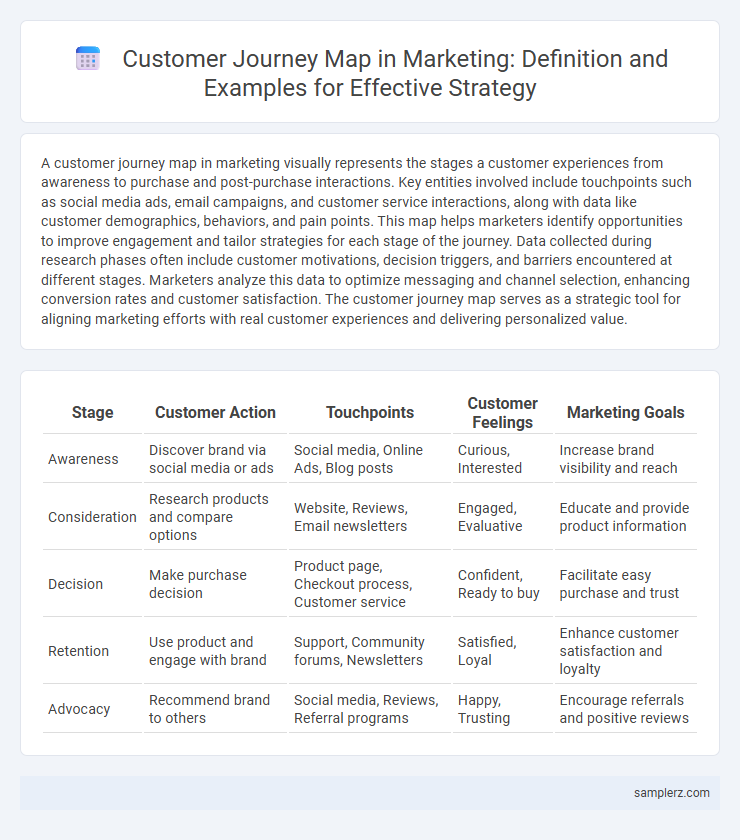A customer journey map in marketing visually represents the stages a customer experiences from awareness to purchase and post-purchase interactions. Key entities involved include touchpoints such as social media ads, email campaigns, and customer service interactions, along with data like customer demographics, behaviors, and pain points. This map helps marketers identify opportunities to improve engagement and tailor strategies for each stage of the journey. Data collected during research phases often include customer motivations, decision triggers, and barriers encountered at different stages. Marketers analyze this data to optimize messaging and channel selection, enhancing conversion rates and customer satisfaction. The customer journey map serves as a strategic tool for aligning marketing efforts with real customer experiences and delivering personalized value.
Table of Comparison
| Stage | Customer Action | Touchpoints | Customer Feelings | Marketing Goals |
|---|---|---|---|---|
| Awareness | Discover brand via social media or ads | Social media, Online Ads, Blog posts | Curious, Interested | Increase brand visibility and reach |
| Consideration | Research products and compare options | Website, Reviews, Email newsletters | Engaged, Evaluative | Educate and provide product information |
| Decision | Make purchase decision | Product page, Checkout process, Customer service | Confident, Ready to buy | Facilitate easy purchase and trust |
| Retention | Use product and engage with brand | Support, Community forums, Newsletters | Satisfied, Loyal | Enhance customer satisfaction and loyalty |
| Advocacy | Recommend brand to others | Social media, Reviews, Referral programs | Happy, Trusting | Encourage referrals and positive reviews |
Introduction to Customer Journey Mapping in Marketing
Customer journey mapping in marketing visualizes the detailed path customers take from awareness to purchase and loyalty, highlighting key touchpoints such as discovery, consideration, and decision stages. This strategic tool enables marketers to identify pain points, optimize customer interactions, and personalize messaging to enhance engagement across channels. Effective journey maps integrate data from CRM systems, social media analytics, and customer feedback to create a comprehensive view of the buyer's experience.
Key Stages of a Marketing Customer Journey
A customer journey map in marketing typically highlights key stages such as awareness, consideration, and decision, each representing a critical phase in consumer interaction. During awareness, potential customers recognize a need or problem, often triggered by marketing campaigns or social media exposure. The consideration stage involves research and comparison of options, while the decision stage culminates in purchase and post-purchase evaluation, guiding marketers in tailoring strategies and content.
Real-World Example: E-commerce Customer Journey Map
An e-commerce customer journey map typically outlines key touchpoints such as awareness through social media ads, consideration via product reviews and comparisons, and purchase facilitated by an easy checkout process. Post-purchase stages include order tracking, customer support interaction, and personalized follow-up emails to encourage repeat business. This mapping helps marketers optimize user experience and increase conversion rates by addressing pain points at each phase.
B2B Customer Journey Map Case Study
A B2B customer journey map example involves a technology vendor targeting enterprise clients, outlining stages such as awareness through industry webinars, evaluation via detailed product demos, and decision-making supported by customized ROI analyses. Mapping these touchpoints helps identify pain points like prolonged approval processes and highlights opportunities for personalized content to enhance buyer engagement. This strategic approach improves conversion rates by aligning marketing efforts with the complex purchasing behaviors of B2B decision-makers.
Visualizing the Customer Journey: Essential Elements
A customer journey map in marketing visualizes key touchpoints such as awareness, consideration, purchase, and loyalty stages. It includes essential elements like customer emotions, pain points, and decision-making processes, aligned with marketing channels and content strategies. This visualization enables marketers to optimize engagement and tailor personalized experiences across multiple platforms.
Touchpoints Analysis in Marketing Campaigns
Touchpoints analysis in marketing campaigns involves identifying and evaluating all customer interactions across channels, including social media, email, and in-store experiences. By mapping these touchpoints, marketers can optimize engagement strategies, enhance customer satisfaction, and increase conversion rates. Understanding the sequence and impact of each touchpoint allows for personalized messaging and improved campaign performance.
Mapping the Digital Customer Experience in Marketing
Mapping the digital customer experience in marketing involves creating a detailed customer journey map that tracks interactions across multiple touchpoints like social media, websites, and email campaigns. This map highlights key stages such as awareness, consideration, purchase, and post-purchase engagement, enabling marketers to identify pain points and optimize user experience. Leveraging data analytics and customer feedback ensures targeted personalization and improved conversion rates throughout the digital funnel.
Optimizing Marketing Strategies with Journey Maps
Customer journey maps reveal critical touchpoints and customer behaviors, enabling marketers to tailor campaigns for higher engagement and conversion rates. By analyzing journey stages such as awareness, consideration, and decision, businesses can allocate resources more efficiently and personalize messaging. Optimizing marketing strategies with journey maps increases customer satisfaction, boosts ROI, and drives long-term brand loyalty.
Common Mistakes in Customer Journey Mapping
Common mistakes in customer journey mapping often include neglecting to gather diverse customer data, resulting in an incomplete or inaccurate representation of buyer personas. Marketers frequently overlook key touchpoints such as post-purchase follow-ups and assume a linear journey, ignoring the complex, non-linear nature of customer interactions across multiple channels. Failing to update the customer journey map regularly prevents businesses from adapting to evolving customer behavior and market trends, diminishing the map's effectiveness in driving targeted marketing strategies.
Future Trends in Customer Journey Mapping for Marketers
Future trends in customer journey mapping emphasize integration of AI-driven analytics to predict customer behavior and personalize experiences in real-time. Marketers increasingly utilize omnichannel data sources to create comprehensive, dynamic journey maps that adapt to evolving consumer preferences. Enhanced visualization tools and sentiment analysis enable deeper insights into emotional drivers, optimizing strategy and customer engagement.

example of customer journey map in marketing Infographic
 samplerz.com
samplerz.com